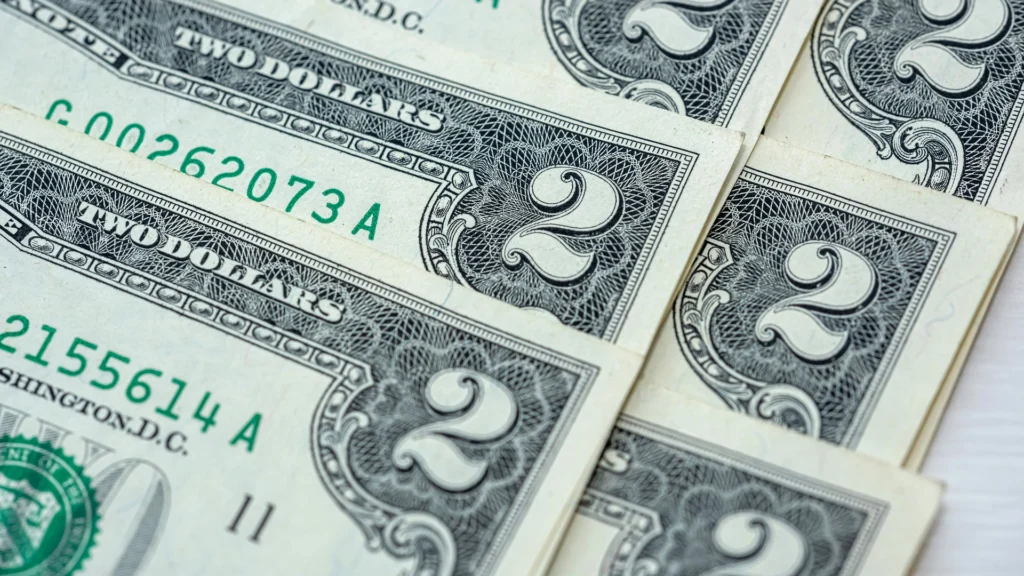
The $2 bill, often less appreciated in comparison to its higher denomination counterparts, has a unique charm of its own. It’s not as common as the other bills, and that’s part of what makes it special. If you have one that’s old, rare, or in mint condition, it could be highly sought after by collectors.
So, next time you come across a $2 bill, remember to give it the respect it deserves. After all, this humble “Thomas Jefferson” could be worth thousands of dollars at this point.
Some newer bills, such as those printed in 2003 could have significant value. One $2 bill from 2003 with a very low serial number recently sold at auction for $2,400. It later resold for $4,000. pic.twitter.com/7YSRbgcSlD
— ABC7 Eyewitness News (@ABC7) November 8, 2023
The history of the $2 bill in the United States is a fascinating journey that dates back to the mid-19th century. The federal government began issuing $2 currency notes in 1862, marking the debut of this unique denomination. Interestingly, the first design of the $2 bill featured a portrait of Alexander Hamilton, one of the founding fathers of the United States.
However, it wasn’t until 1869 that Thomas Jefferson, the third President of the United States, became the face of the $2 bill. This change was made by the Bureau of Engraving and Printing, the agency responsible for producing the nation’s currency.
Since Jefferson’s portrait was introduced, the $2 bill has undergone a series of transformations. In fact, there have been six different designs of the $2 currency note to date. Each new design represents a chapter in the rich history of this often overlooked, yet incredibly valuable piece of currency. So, if you’re lucky enough to possess a $2 bill, know that you’re holding a piece of history in your hands.
The value of your $2 bill can significantly exceed its face value, depending on a variety of factors. The year of issuance and the condition of the bill, particularly whether it has been circulated or not, play a crucial role in determining its worth.
While a $2 bill might typically be enough to cover a meal at a fast-food restaurant, in certain circumstances, it could be worth much more. For instance, if the bill is from an earlier year and has been well-preserved, it could be of great interest to collectors and therefore hold a higher value.
The value of a $2 currency note can sometimes be quite surprising, as evidenced by recent sales on Heritage Auctions. For instance, a $2 bill minted in 2003 was sold online for a staggering $2,400 in July. But that’s not the end of the story. The same bill was sold again just two weeks later, this time fetching an even higher price of $4,000.
This is not an isolated case. Other $2 notes from the same year, 2003, have also been sold for prices significantly above their face value, reaching into the hundreds of dollars and even higher. These instances highlight the potential value of $2 bills, particularly for collectors or those interested in numismatics. So, if you happen to have a $2 bill, especially one from a specific year or in mint condition, you might be holding onto a small treasure.
If you’re interested in determining the value of your $2 bill, there are a few key factors to consider. The year of issuance and the color of the seal on the bill are particularly important.
Bills that were issued from 1862 through 1917 and feature red, brown, or blue seals can potentially be quite valuable. In fact, these bills can be worth up to $1,000 or even more, according to the U.S. Currency Auctions website. This website determines the value of bills based on recent and past paper currency auctions, providing a reliable estimate of what your $2 bill might be worth.
According to the information provided on a certain website, a collection of 12 banknotes, dating back to 1995 and preserved in their original packaging, could potentially fetch a value of $500 or more. This indicates that these notes have significantly appreciated in value over time, making them a potentially lucrative investment for collectors.
To ascertain the exact value of your $2 bill, the website offers a comprehensive U.S. currency price guide. This guide is accessible online and provides detailed pricing information for various types of U.S. currency, including $2 bills. You can visit this guide on the website at uscurrencyauctions to determine the current market value of your $2 bill. This could be particularly useful if you are considering selling your bill or simply wish to understand its worth in the current market.
The value of currency can also be fluctuate based on various factors, including condition, rarity, and demand among collectors. Therefore, the prices listed in the guide should be used as a reference and may not reflect the exact amount you could receive if you were to sell your bill.
ALSO READ | The White House proposes a $105 billion budget to support Israel, Ukraine and more